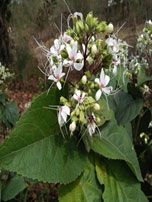Bhandirah

Botanical Name : Clerodendrum infortunatum auct. non Linn. C.B.Clarke.
Family : Verbenaceae.
Introduction :
This plant used in Ayurveda, homeo and folk medicine for constipation and piles.
Names in different Indian languages :
Hindi : Titabhamt, Bhates
Kannada : Basavana pada, ibbane
Malayalam : Peruku
Sanskrit : Bhandirah
Tamil : Perukilai, Karukanni
Telugu : Gurrapu katiyaku
Synonyms :
Bhaandira, Bhaandi, Kaari,
C. viscosum auct. Non Vent.
Varieties & adulterants – (CV – controversy, AD – adulterants) :
C. serratum
Morphology :
It is a shrub grows 5-6 m
Leaves – cordate, simple, hairy, large,
Flower – white, terminal panicle
Fruit – drupes
Distribution & Habitat :
All over India
Chemical constituents :
ceryl alcohol,clerodin, clerosterol and clerodendrin A
Properties :
RASA- tiktha, kashaya
GUNA-laghu
VIRYA-ushna
VIPAKA-katu
Karma : garbasangajith, krimighna, kasaghna
Laxative, thermogenic, bitter , analgesic
Internal uses :
Digestive system: purgative
Skin: Skin disease
Indication :
Krimi, jwara, madhumeha
Alopecia, skin disease, worm infection, piles
Part used :
Leaves, root
Dosage :
1-2 g
Therapeutic Uses :
1. Leaves are prescribed in headache.
2. Roots are given in cramps and rheumatism.
3. water boiled with root used for ‘avaghaha’ for painful piles.